-
 Bitcoin
Bitcoin $101,879.1748
-1.43% -
 Ethereum
Ethereum $2,536.5143
-2.74% -
 Tether USDt
Tether USDt $0.9999
0.00% -
 XRP
XRP $2.4655
-6.31% -
 BNB
BNB $648.5754
-0.93% -
 Solana
Solana $170.2505
-5.19% -
 USDC
USDC $0.9998
-0.02% -
 Dogecoin
Dogecoin $0.2242
-4.65% -
 Cardano
Cardano $0.7666
-6.09% -
 TRON
TRON $0.2683
-1.91% -
 Sui
Sui $3.7212
-5.31% -
 Chainlink
Chainlink $16.2208
-4.54% -
 Avalanche
Avalanche $23.7056
-7.49% -
 Stellar
Stellar $0.2949
-6.11% -
 Shiba Inu
Shiba Inu $0.0...01491
-6.19% -
 Hedera
Hedera $0.1987
-5.94% -
 UNUS SED LEO
UNUS SED LEO $8.8970
0.62% -
 Hyperliquid
Hyperliquid $24.4499
-3.33% -
 Bitcoin Cash
Bitcoin Cash $391.0755
-3.62% -
 Toncoin
Toncoin $3.0817
-7.84% -
 Polkadot
Polkadot $4.7651
-6.22% -
 Litecoin
Litecoin $96.6880
-5.44% -
 Monero
Monero $344.1940
1.46% -
 Pi
Pi $0.8796
-25.20% -
 Pepe
Pepe $0.0...01343
-4.04% -
 Bitget Token
Bitget Token $4.7646
-0.40% -
 Dai
Dai $1.0000
0.00% -
 Ethena USDe
Ethena USDe $1.0004
-0.02% -
 Uniswap
Uniswap $6.3256
-5.65% -
 Bittensor
Bittensor $422.3233
-7.08%
What is the reason for the high rejection rate of the mining pool? How to optimize?
High rejection rates in mining pools can stem from network latency, hardware issues, or misconfiguration; optimizing these can boost mining efficiency and profitability.
May 15, 2025 at 11:35 am
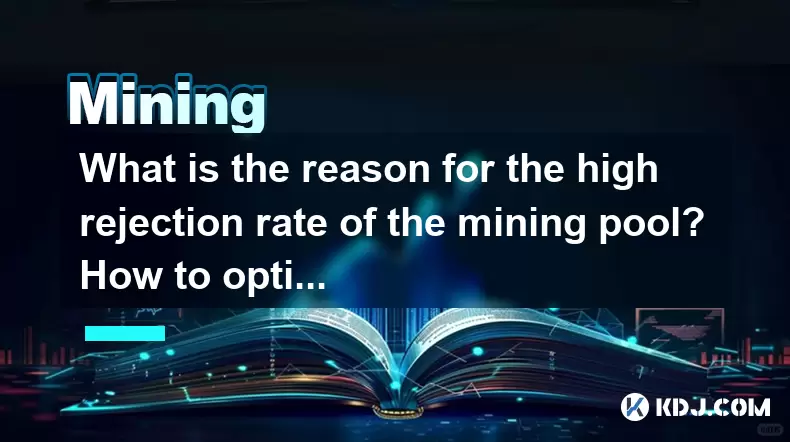
The high rejection rate of a mining pool is a common concern for many cryptocurrency miners. Rejection rates refer to the percentage of submitted shares that are rejected by the mining pool. A high rejection rate can significantly impact a miner's profitability and efficiency. In this article, we will explore the reasons behind high rejection rates and provide detailed strategies to optimize your mining operations.
Understanding Rejection Rates in Mining Pools
Rejection rates occur when the mining pool deems a submitted share invalid. This can happen for several reasons, including network latency, hardware issues, or incorrect configuration settings. Understanding the root causes of high rejection rates is crucial for optimizing your mining setup.
Common Reasons for High Rejection Rates
There are several factors that can contribute to high rejection rates in mining pools. Let's delve into the most common reasons:
Network Latency: If the connection between your mining rig and the mining pool server is slow or unstable, it can lead to delays in share submission. These delays can cause the pool to reject shares that are submitted too late.
Hardware Issues: Problems with your mining hardware, such as overheating or faulty components, can result in incorrect calculations and, consequently, rejected shares.
Incorrect Configuration: If your mining software is not configured correctly, it may submit shares that do not meet the pool's requirements. This includes settings related to the mining algorithm, pool address, and worker credentials.
Pool Server Issues: Sometimes, the problem lies with the mining pool itself. Server overload or technical issues on the pool's end can lead to higher rejection rates for all miners connected to that pool.
How to Diagnose High Rejection Rates
To effectively address high rejection rates, you need to diagnose the issue accurately. Here are some steps to help you identify the root cause:
Monitor Your Mining Software: Most mining software provides real-time data on rejection rates. Keep an eye on these metrics to identify any sudden spikes or consistent high rates.
Check Network Stability: Use tools like ping and traceroute to assess the stability and speed of your connection to the mining pool. Consistent high latency or packet loss can indicate network issues.
Inspect Hardware Health: Regularly check the temperature and performance of your mining hardware. Use software like GPU-Z or HWiNFO to monitor your hardware's health.
Review Pool Performance: Check the mining pool's status page or forums to see if other miners are experiencing similar issues. This can help you determine if the problem is pool-related.
Optimizing Your Mining Setup to Reduce Rejection Rates
Once you have identified the cause of high rejection rates, you can take steps to optimize your mining setup. Here are some strategies to help you reduce rejection rates and improve your mining efficiency:
Improve Network Connectivity: If network latency is the issue, consider upgrading your internet connection or using a different internet service provider. You can also try connecting to a mining pool server that is geographically closer to your location.
Optimize Hardware Performance: Ensure that your mining hardware is operating within safe temperature limits. Use cooling solutions like fans or liquid cooling to prevent overheating. Regularly clean your hardware to remove dust and improve airflow.
Correct Configuration Settings: Double-check your mining software settings to ensure they match the requirements of your mining pool. Pay attention to settings like the mining algorithm, pool address, and worker credentials. If you are unsure, consult the pool's documentation or support team.
Switch Mining Pools: If the issue persists and you suspect it is related to the mining pool, consider switching to a different pool. Look for pools with a good reputation for reliability and low rejection rates.
Detailed Steps to Configure Mining Software
To help you with the configuration process, here are detailed steps to set up your mining software correctly:
Download and Install Mining Software: Choose a reputable mining software that supports your mining hardware and the cryptocurrency you want to mine. Popular options include CGMiner, EasyMiner, and NiceHash.
Configure Pool Settings:
- Open the mining software and navigate to the pool configuration section.
- Enter the pool address provided by your mining pool. This is usually in the format of
stratum+tcp://pool_address:port. - Enter your worker name and password. These are provided by the mining pool when you create an account.
Set Mining Algorithm:
- Select the appropriate mining algorithm for the cryptocurrency you are mining. For example, Bitcoin uses the SHA-256 algorithm, while Ethereum uses Ethash.
- Ensure that your mining hardware supports the chosen algorithm.
Adjust Advanced Settings:
- Some mining software allows you to adjust advanced settings like the intensity of mining, thread concurrency, and GPU settings. Experiment with these settings to find the optimal configuration for your hardware.
Start Mining:
- Once all settings are configured, start the mining process. Monitor the software's output to ensure that shares are being submitted and accepted by the pool.
Monitoring and Maintaining Your Mining Setup
To maintain low rejection rates over time, it's important to regularly monitor and maintain your mining setup. Here are some tips:
Regularly Update Software: Keep your mining software and drivers up to date to ensure compatibility and performance improvements.
Monitor Rejection Rates: Continuously monitor your rejection rates and investigate any sudden changes. Use the diagnostic steps mentioned earlier to identify and address issues promptly.
Perform Hardware Maintenance: Regularly clean your mining hardware and check for any signs of wear or damage. Replace faulty components as needed to maintain optimal performance.
Stay Informed: Keep up with the latest news and updates from your mining pool. Pool operators often provide tips and recommendations for optimizing mining performance.
Frequently Asked Questions
Q: Can switching to a different mining pool always solve high rejection rates?
A: Not always. While switching pools can help if the issue is pool-related, high rejection rates can also be caused by network or hardware issues on your end. It's important to diagnose the root cause before making a switch.
Q: How often should I monitor my mining setup for rejection rates?
A: It's recommended to check your rejection rates at least once a day. If you notice any sudden spikes or consistently high rates, investigate further to identify and resolve the issue.
Q: Are there any tools that can help me monitor my mining setup more effectively?
A: Yes, there are several tools available. For network monitoring, you can use tools like PingPlotter or MTR. For hardware monitoring, software like GPU-Z, HWiNFO, and MSI Afterburner can provide detailed insights into your hardware's performance and health.
Q: Can overclocking my mining hardware affect rejection rates?
A: Yes, overclocking can lead to higher rejection rates if it causes your hardware to become unstable. If you choose to overclock, do so cautiously and monitor your hardware's stability and rejection rates closely.
Disclaimer:info@kdj.com
The information provided is not trading advice. kdj.com does not assume any responsibility for any investments made based on the information provided in this article. Cryptocurrencies are highly volatile and it is highly recommended that you invest with caution after thorough research!
If you believe that the content used on this website infringes your copyright, please contact us immediately (info@kdj.com) and we will delete it promptly.
- As the crypto market edges back into a state of greed and optimism, several standout projects are positioning themselves for major growth
- 2025-05-15 18:35:12
- The meme coin launchpad market on the Solana blockchain is undergoing a major change
- 2025-05-15 18:35:12
- Kusal Mendis to Replace Jos Buttler in Gujarat Titans Squad for IPL 2025 Playoffs
- 2025-05-15 18:30:13
- Bitcoin Solaris (BTC-S) Isn't Tweaking DeFi — It's Overhauling Its Core
- 2025-05-15 18:30:13
- Part 2 Recap: The Airdrop Economy
- 2025-05-15 18:25:12
- By reducing friction on Launchpool participation and BNB benefits, Binance aims to create a smoother experience for both new and seasoned crypto participants.
- 2025-05-15 18:25:12
Related knowledge
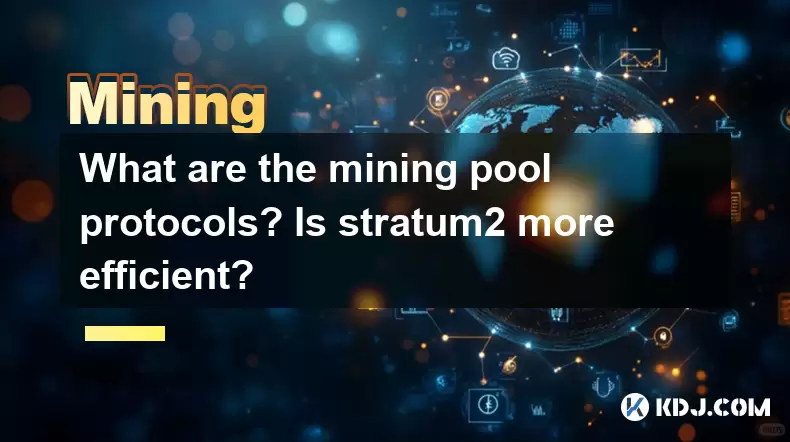
What are the mining pool protocols? Is stratum2 more efficient?
May 15,2025 at 03:35pm
Mining pool protocols are essential components of cryptocurrency mining operations, allowing miners to work together and share resources to increase their chances of earning rewards. The most commonly used protocols include Stratum, Stratum V2 (also known as Stratum2), and Getwork. Each protocol has its own set of features and efficiencies, which can si...

What is the reason for the high rejection rate of the mining pool? How to optimize?
May 15,2025 at 11:35am
The high rejection rate of a mining pool is a common concern for many cryptocurrency miners. Rejection rates refer to the percentage of submitted shares that are rejected by the mining pool. A high rejection rate can significantly impact a miner's profitability and efficiency. In this article, we will explore the reasons behind high rejection rates and ...
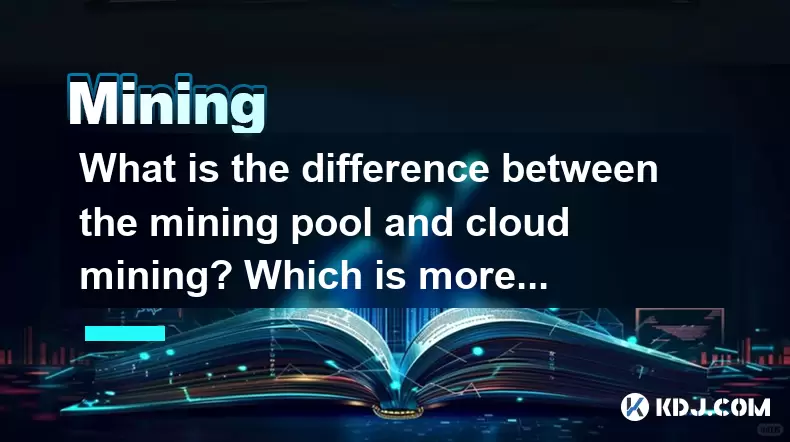
What is the difference between the mining pool and cloud mining? Which is more suitable for novices?
May 14,2025 at 08:56pm
Mining in the cryptocurrency world refers to the process of verifying transactions and adding them to the blockchain, which in turn releases new coins as a reward. Two popular methods of participating in this process are through mining pools and cloud mining. Both have their own set of characteristics, advantages, and disadvantages. This article aims to...
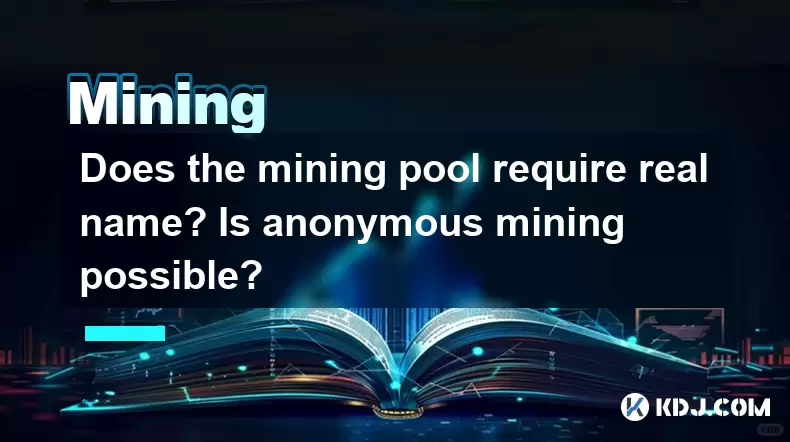
Does the mining pool require real name? Is anonymous mining possible?
May 15,2025 at 11:14am
In the realm of cryptocurrency, mining pools play a crucial role in enabling miners to combine their computational resources to increase their chances of earning rewards. A common concern among miners is the issue of privacy and anonymity, leading to questions about whether mining pools require real names and if anonymous mining is possible. This articl...
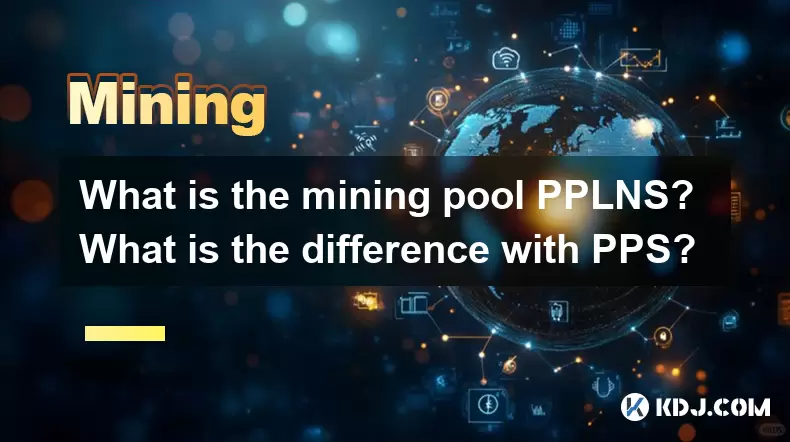
What is the mining pool PPLNS? What is the difference with PPS?
May 15,2025 at 09:35am
Introduction to Mining PoolsIn the world of cryptocurrency, mining pools are collaborative groups where miners combine their computational resources to increase their chances of solving the cryptographic puzzles required to validate transactions and add them to the blockchain. By working together, miners in a pool can share the rewards based on the cont...
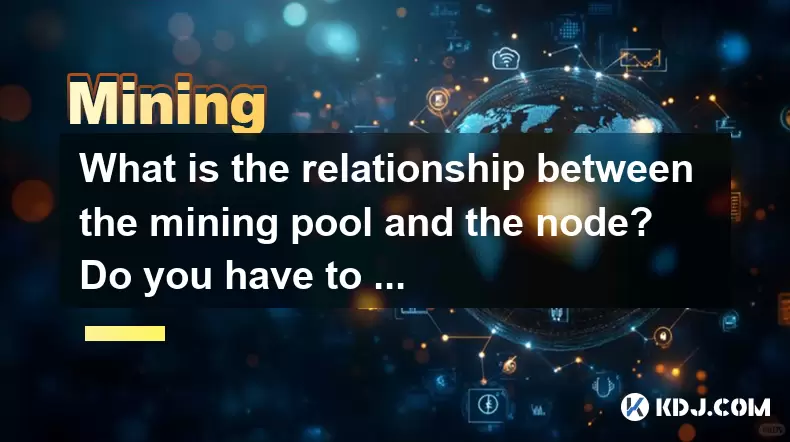
What is the relationship between the mining pool and the node? Do you have to rely on the mining pool?
May 14,2025 at 08:36pm
The relationship between a mining pool and a node in the cryptocurrency ecosystem is intricate and fundamental to understanding how blockchain networks operate. A mining pool is a group of miners who work together to solve complex mathematical problems to validate transactions and add them to the blockchain. On the other hand, a node is a computer conne...

What are the mining pool protocols? Is stratum2 more efficient?
May 15,2025 at 03:35pm
Mining pool protocols are essential components of cryptocurrency mining operations, allowing miners to work together and share resources to increase their chances of earning rewards. The most commonly used protocols include Stratum, Stratum V2 (also known as Stratum2), and Getwork. Each protocol has its own set of features and efficiencies, which can si...

What is the reason for the high rejection rate of the mining pool? How to optimize?
May 15,2025 at 11:35am
The high rejection rate of a mining pool is a common concern for many cryptocurrency miners. Rejection rates refer to the percentage of submitted shares that are rejected by the mining pool. A high rejection rate can significantly impact a miner's profitability and efficiency. In this article, we will explore the reasons behind high rejection rates and ...

What is the difference between the mining pool and cloud mining? Which is more suitable for novices?
May 14,2025 at 08:56pm
Mining in the cryptocurrency world refers to the process of verifying transactions and adding them to the blockchain, which in turn releases new coins as a reward. Two popular methods of participating in this process are through mining pools and cloud mining. Both have their own set of characteristics, advantages, and disadvantages. This article aims to...

Does the mining pool require real name? Is anonymous mining possible?
May 15,2025 at 11:14am
In the realm of cryptocurrency, mining pools play a crucial role in enabling miners to combine their computational resources to increase their chances of earning rewards. A common concern among miners is the issue of privacy and anonymity, leading to questions about whether mining pools require real names and if anonymous mining is possible. This articl...

What is the mining pool PPLNS? What is the difference with PPS?
May 15,2025 at 09:35am
Introduction to Mining PoolsIn the world of cryptocurrency, mining pools are collaborative groups where miners combine their computational resources to increase their chances of solving the cryptographic puzzles required to validate transactions and add them to the blockchain. By working together, miners in a pool can share the rewards based on the cont...

What is the relationship between the mining pool and the node? Do you have to rely on the mining pool?
May 14,2025 at 08:36pm
The relationship between a mining pool and a node in the cryptocurrency ecosystem is intricate and fundamental to understanding how blockchain networks operate. A mining pool is a group of miners who work together to solve complex mathematical problems to validate transactions and add them to the blockchain. On the other hand, a node is a computer conne...
See all articles


























![[Ronnie Trading Guide]-2025.5.15-Bitcoin continues to consolidate at a high level, and only patient investors will get a return on time~ [Ronnie Trading Guide]-2025.5.15-Bitcoin continues to consolidate at a high level, and only patient investors will get a return on time~](/uploads/2025/05/15/cryptocurrencies-news/videos/ronnie-trading-guidebitcoin-continues-consolidate-level-patient-investors-return-time/682574fd46a42_image_500_375.webp)





























































